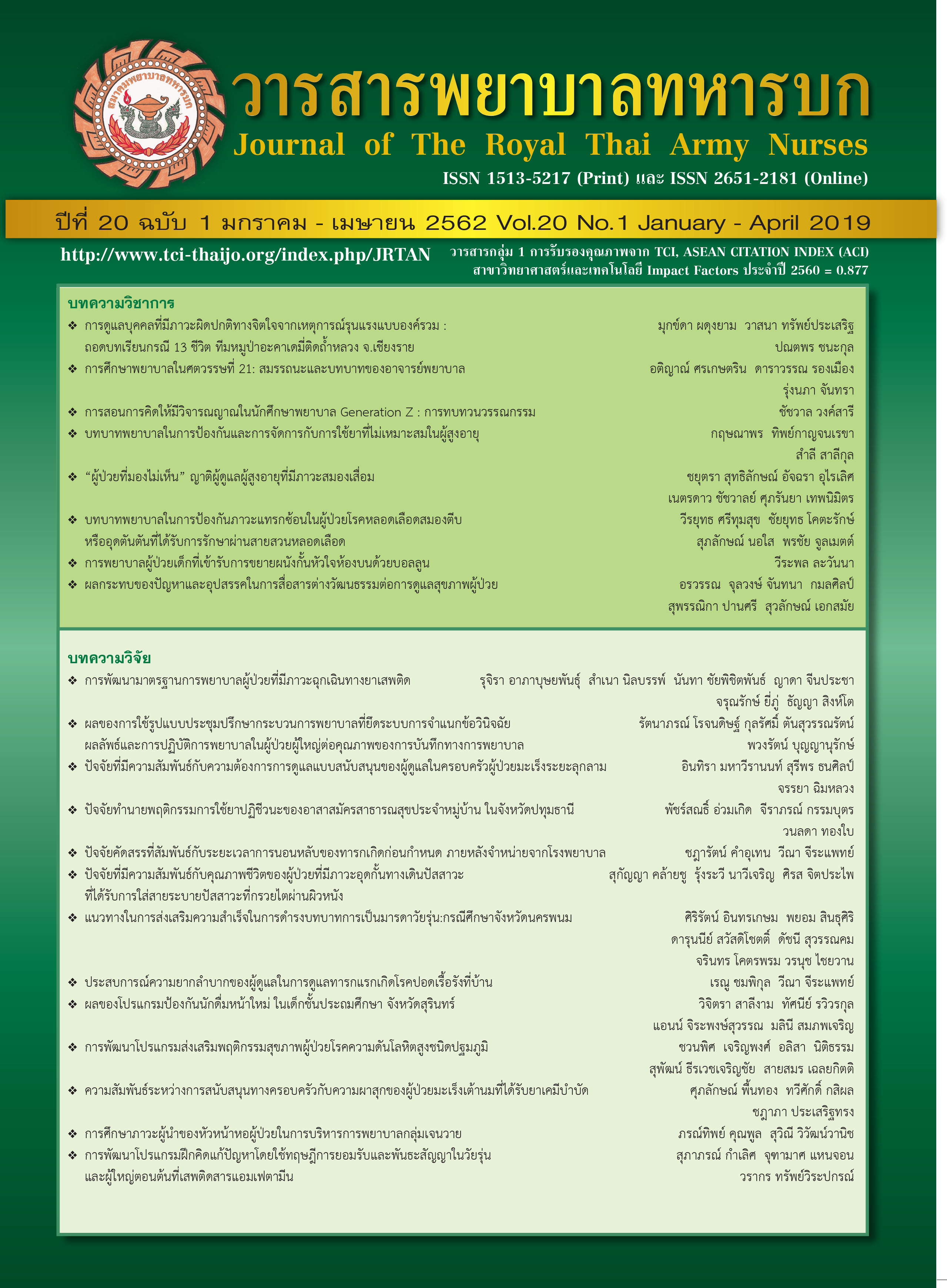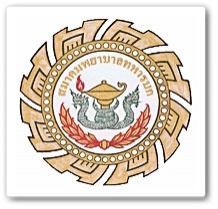Factors Predicting Antibiotic use Behavior Among Healthcare Volunteers in Pathumthani Province, Thailand
Keywords:
antibiotic use behavior, healthcare volunteersAbstract
The purpose of this research is to study the factors that predict the antibiotic use behavior of healthcare volunteers. The research applied the 3rd step, PRECEDE- PROCEED model. The population was healthcare volunteers in Pathumthani province, Thailand. The cluster and simple random sampling were used to recruit 205 people. The data were collected using interviews from January, 2018 to March, 2018. The research instrument was an interview questionnaire, consisting of the predisposing factors, enabling factors, reinforcing factors, and antibiotic use behaviors. Those were Cronbach’s Alpha coefficients in healthcare volunteer’s antibiotic use behavior data questionnaires at 0.86, in attitude of antibiotic use data questionnaire at 0.78, antibiotic use knowledge data questionnaire were KR21 coefficients at 0.86. The data were analyzed using descriptive statistics and multiple regression analysis method. The results revealed that antibiotic use behavior of volunteer was at a high range (M = 29.20, SD. = 2.38). The factors of attitude (ß = -0.264), with monthly income higher than 30,000 THB per month (ß = 0.163), being female (ß = -0.165), having antibiotic use knowledge and medicinal properties (ß = -0.134) in combination with significantly predicted the antibiotic use behavior of the healthcare volunteers in Pathumtani Province, Thailand at a significant level of .05, explaining 18 percent of the variance (F = 4.109, p<0.044) According to the above mentioned findings, the public health organizations should provide activities to promote the right understanding, knowledge of proper antibiotic use for healthcare volunteers that should build higher awareness and rationales for using antibiotics. In addition, they could be able to convey this knowledge to their community afterward.
Downloads
References
Chuengsatiansup K. Seading of health care service and sickness healing: Social thinking and medical anthropology. Bangkok: Social and Health Research center; 2007.
Chuengsatiansup K. Sringuenyuang L, Paonin W. Medicine and community: Social and culture dimension. 2nd ed. Bangkok: Wandee book; 2007.
Sumpradit N, Hunnakool S, Prakongsai P, Thammalikit W. Distribution and utilization of antibiotics in health promoting hospitals, private medical clinics and pharmacies in Thailand. Journal of healthcare system research. 2012;7(2):268-280 (in Thai)
Kasettat N, Putlerpong C. Pharmacotherapy in infection disease : from evidence-base to pharmaceutical care. Bangkok: faculty of pharmacy Chulalongkorn University. 2009.
Modsikapun P. Antibiotic use in infectious disease in hospital. Journal of northeastern medicine. 2012;11(3):79-89 (in Thai)
Punpanich R, Siwirote P, Saenchaisuriya P, Tatniyom S, Aungsuroj Y, Pretekitti W. Antibiotics prescription rates for upper respiratory tract infections in Thai national health insurance systems. Journal of Public Health Academic. 2002.
Malatham K. Crisis of antibiotic resistant and antibiotic use in Thailand. Annual medicine system report 2009: Antibiotic resistance situation. Bangkok: Surveillance plan and medicine system development; 2009.
Dejsirilert S. Annual medicine of year 2010: Drug resistance situation and problem in antibiotic use. Bangkok: Plan of drug surveillance and
development. 2011.
Luweera W. Overview of antibiotic resistance. Journal of Songkhalanakarin University. 2005; 24(5): 454-458. (in Thai)
Food and Drug Administration. Academic and Planning Unit. Health Product Serviellance: Spontaneous reports of adverse drug reaction. 2011.
Pumas P, Phota T, Thummalikit W, Prakongsai, Limwatatnanon S, Riewpaiboon A. Health and ecomomic impacts of antimicrobial resistance
infection in Thailand: A preliminary study. Journal of Public Health Research. 2012; 6(3):352-359 (in Thai)
Soontorntham S. National health security system. Bangkok: National health security office; 2012.
Chayakoon C, Jongtrakool P, Wananukool W, Punnapurot P, Kanchanarat P, Yodsombat K, et al. Rational drug use hospital manual. Bangkok: The Agriculture Co-operative Federation of Thailand 2013. Journal of Eastern-Asia University. 2012;91-99 (in Thai)
Mongkolchaiphak J, Raumsuk J, Chaiprateep A. The study of customer’s knowledge and behavior in using antibiotics at community drug store in Pathumthani Province. Journal of Eastern-Asia University. 2012; 91-99 (in Thai)
Shehadeh, M., Suaifan, G., Darwish, R.M., Wazaify, M., Zuru, L., & Alja’fari, S. Knowledge, attitude and behavior regarding antibiotics use and
misuse among adults in the community of Jordan. [A pilot study]. Saudi Phamaceutical Journal. 2012;20:125-133.
Wongwan T. Knowledge on antibiotic use for acute upper respiratory tract infections among outpatients with that infections at Queen Savang Vadhana Memorial Hospital. Journal of Thai pharmacy. 2014;6(2):106-114 (in Thai)
Parisuttiwuttiporn S, Hemchayad M. Factors influencing factors of antibiotics use behavior of clients in Khlunk hospital, Junthaburi. Journal of Clinical Medicine Pharpokkaow Hospital. 2014;31(2):114-127.
Thongrod W. Sufficient drug use: Antibiotic. Moo Chao Ban magazine. 2007;(11)349.
Emeka, P. M., Al-Omar, M., & Khan, T. M. (2014). Public attitude and justification to purchase antibiotics in the eastern region AL Ahsa of Saudi Arabia. Saudi Pharmaceutical Journal. 2014;22:550-554.
Jose, J., Jimmy, B., Ghalay, A.G.M.S., & Sabei, G.A. A study assessing public knowledge, belief and behavior of antibiotic use in an Omani population. Oman Medical Journal. 2013; 28(5):324-330. DOI: 10.5001/omj.2013.95.
Saengcharoen, W., Chongsuvivatwong, V., Lerkiatbundit, S., & Wongpoowarak, P. Factor influencing dispensing of antibiotics for upper respiratory infection among Southern Thai community pharmacists. Journal of Clinical Phamacy And Therapeutics. 2008;33:123-129.
Green, L.W., & Kreuter, M. W. Ecological and educational diagnosis. Health Program Planning An Educational And Ecological Approach. (4th Eds), New York: Quebecor World Fairfield Inc. 2005:147-189.
Onsri P. Glideline for the development of research competency in the nursing profession, Thailand 4.0 era. Journal of The Royal Thai Army Nurse. 2018;19(1):24-29 (in Thai)
Faul, F., Erdfelder, E., Buchner, A. & lang, A. (2009). Statistical power analysis using G*Power 3.1: Test for correlation and regression analysis.
Behavior Research Methods. 2009;41(4): 1149-60.
Barbara Hazard Munro. Statistical Method for Health Care Research. (5th ed.) Philadelphia: R.R Donnelly; 2005.
Khamwong D, Sangkawat T. Factors affecting drug use behaviors of village health volunteers. Journal of Pharbarmrajchanok Institute
Sirintorn Health care Collage, Chonburi. 2012 (in Thai)
wittayapichetkool S, Sitibud U. Drug use behavior of village health volunteer at Bo kwangtong sub-district, Bo tong district, Chonburi province.
Journal of Public health Burapha University. 2014; 9(1): 117-128.
Cohen J. Statistical power analysis for the behavioral sciences. (2nd ed.). New Jersey: Lawrence Erlbaum; 1988.
Sirijoti, K., Hongsranagon, P., Havanond, P., & Pannoi, W. Assessment of knowledge attitudes and practices regarding antibiotic use in Trang
province, Thailand. J Health Res. 2014;289(5): 299-307.
Wun,Y.T., Lam, T.P., Lam, K.F., & Sun, K.S. Comparison of the knowledge, attitudes and practice with antibiotic use between traditional Chinese medicine and western medicine usual attenders in Hong Kong. Complementary Therapies In Medicine. (2014); 22:99-106.
Downloads
Published
How to Cite
Issue
Section
License
บทความหรือข้อคิดเห็นใดใดที่ปรากฏในวารสารพยาบาลทหารบกเป็นวรรณกรรมของผู้เขียน ซึ่งบรรณาธิการหรือสมาคมพยาบาลทหารบก ไม่จำเป็นต้องเห็นด้วย
บทความที่ได้รับการตีพิมพ์เป็นลิขสิทธิ์ของวารสารพยาบาลทหารบก
The ideas and opinions expressed in the Journal of The Royal Thai Army Nurses are those of the authors and not necessarily those
of the editor or Royal Thai Army Nurses Association.






